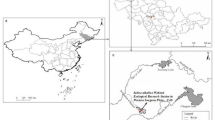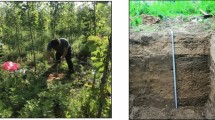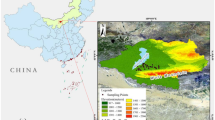Abstract
Phosphorous (P) is an essential nutrient in soil which can lead to eutrophication when eroding into rivers or lakes. As a new method to represent soil properties, fractal theory was applied to study soil characteristics and related process. To understand the correlation of total soil P (TSP) and fractal dimension (D) with the effect of soil depth and slope gradient, soil grid samples were collected at 0–10, 10–20 and 20–40 cm depths in Yingwugou watershed, Yangtze River, China. The physico-chemical properties of the samples were analyzed to determine the TSP content and D. Fractal scaling theory was then applied to establish the relationship between D and TSP. With silt as the dominant particle size, the D values of the study area were in the range of 2.42–2.55. On the flat ground, more fine particles (clay and silt) were reserved and on the contrary relatively high content of coarse sand was retained on steep slope. D values decreased with slope and soil depth increased. The average TSP contents of the three layers were 0.65, 0.63 and 0.57 g/kg for 0–10, 10–20 and 20–40 cm, respectively, showing a decreasing tendency with increased soil depth. With increasing slope gradient, the TSP contents decreased first and then increased slowly. The TSP contents were positively related to silt content (P < 0.05) and clay content (P < 0.05) and negatively associated with sand contents (P < 0.01). There was an one-dimensional linear relationship (n = 530, R 2 = 0.16, P < 0.01) between TSP content and D values. The correlation would improve when concrete slope was taken into account. To better understand and control soil erosion, the relationship between D value and soil nutrients deserves more attention.





Similar content being viewed by others
References
Abbas A, Mohammad-Reza N, Hassan R, Hossein A (2011) Fractal dimension of soil aggregates as an index of soil erodibility. J Hydrol 400:305–311
Adejuwon JOA, Ekanade O (1988) A comparison of soil properties under different landuse types in a part of the Nigerian cocoa belt. Catena 15:319–331
Albanese S, De Vivo B, Lima A, Cicchella D (2007) Geochemical background and baseline values of toxic elements in stream sediments of Campania region (Italy). J Geochem Explor 93:21–34
Andrés D, Cristina C, Fernando M et al (2009) Response of earthworm communities to soil disturbance: Fractal dimension of soil and species’ rank-abundance curves. Appl Soil Ecol 43:83–88
Cheng Q, Agterberg FP, Ballantyne SB (1994) The separation of geochemical anomalies from background by fractal methods. J Geochem Explor 51:109–130
Cooper CM (1993) Biological effects of agriculturally derived surface water pollutants on aquatic systems—a review. J Environ Qual 22:402–408
Coşkun G (2006) Effect of forage cropping treatments on soil structure and relationships with fractal dimensions. Geoderma 131:33–44
Daniel RH, Daniel G, Vandana S, Brian FP (2013) Fractal distribution of mass from the millimeter- to decimeter-scale in two soils under native and restored tallgrass prairie. Geoderma 207–208:121–130
Delgado A, Scalanghe R (2008) Aspects of phosphorus transfer from soils in Europe. J Plant Nutr Soil Sci 171:552–575
Deng J, Wang QF, Yang LQ et al (2010) Delineation and explanation of geochemical anomalies using fractal models in the Heqing area, Yunnan province, China. J Geochem Explor 105:95–105
Elci S, Selcuk P (2013) Effects of basin activities and land use on water quality trends in Tahtali Basin, Turkey. Environ Earth Sci 68:1591–1598
Erasahin S, Gunal H, Kutlu T, Yetgin B, Coban S (2006) Estimating specific surface area and cation exchange capacity in soils using fractal dimension of particle-size distribution. Geoderma 136:588–597
Fernández-Martínez M, Sánchez-Granero MA (2013) Fractal dimension for fractal structures. http://dx.doi.org/10.1016/j.topol.2013.10.010
Frontier S (1987) Applications of fractal theory to ecology. In: Legendre P, Legendre L (eds) Developments in numerical ecology, vol G14. NATO ASI Series, p 585
Hamid G, Ahmad RM, David RC (2013) A comparison of fractal methods and probability plots in identifying and mapping soil metal contamination near an active mining area, Iran. Sci Total Environ. 463–464:845–854
Hany EK, Zhang HF, Zhang PC et al (2013) Soil erosion and surface runoff on different vegetation covers and slope gradients: a field experiment in Southern Shaanxi Province, China. Catena 105:1–10
Jin XC, Tu QY (1990) Standards for Lake Eutrophication Investigation. China Environmental Science, Beijing (in Chinese)
Kim SW, Park JS, Kim D et al (2014) Runoff characteristics of non-point pollutants caused by different land uses and a spatial overlay analysis with spatial distribution of industrial cluster: a case study of the Lake Sihwa watershed. Environ Earth Sci 71:483–496
Li C, Ma T, Shi J (2003) Application of a fractal method relating concentrations and distances for separation of geochemical anomalies from background. J Geochem Explor 77:167–175
Li SY, Gu S, Tan X, Zhang QF (2009) Water quality in the upper Han River basin, China: the impacts of land use/land cover in riparian buffer zone. J Hazard Mater 165:317–324
Li SY, Li J, Zhang QF (2011) Water quality assessment in the rivers along the water conveyance system of the Middle Route of the South to North Water Transfer Project (China) using multivariate statistical techniques and receptor modeling. J Hazard Mater 195:306–317
Li MM, Zhang XC, Pang GW, Han FP (2013) The estimation of soil organic carbon distribution and storage in a small catchment area of the Loess Plateau. Catena 101:11–16
Luis AC, Jorge RV, Luis MG, Arturo Q (2012) Characterization of spherical core-shell particles by static light scattering. Estimation of the core- and particle-size distributions. J Quant Spectrosc Radiat Transfer 113:2255–2264
Mandelbort BB (1982) The fractal geometry of nature. Freeman M, San Francisco, pp 45–256
Mandelbrot BB (1967) How long is the coast of Britain? Statistical self-similarity and fractional dimension. Science 165:636–638
Marciel R, Sylvie R, Celso A et al (2014) How the chemical composition and heterogeneity of crop residue mixtures decomposing at the soil surface affects C and N mineralization. Soil Biol Biochem 78:65–75
McDowell RW, Sharpley AN, Folmar G (2003) Modification of phosphorus export from an eastern USA catchment by fluvial sediment and phosphorus inputs. Agric Ecosyst Environ 99:187–199
Misra RK, Teixeira PC (2001) The sensitivity of erosion and erodibility of forest soils to structure and strength. Soil Tillage Res 59(1–2):81–93
Moreno-de las HM (2009) Development of soil physical structure and biological functionality in mining spoils affected by soil erosion in a Mediterranean–continental environment. Geoderma 149(3–4):249–256
Nielsen KL, Miller CR, Beck D, Lynch JP (1999) Fractal geometry of root systems: field observations of contrasting genotypes of common bean (Phaseolus vulgaris L.) grown under different phosphorus regimes. Plant Soil 206:181–190
Oldrich Z, Peter D, Michal V (2013) Entropy of fractal systems. Comput Math Appl 66:135–146
Patrick L, Nubia R, Orlando A, Jaime B, Cesar B et al (2014) Soil ecosystem services and land use in the rapidly changing Orinoco River Basin of Colombia. Agric Ecosyst Environ 185:106–117
Prosperini N, Perugini D (2008) Particle size distributions of some soils from the Umbria Region (Italy): fractal analysis and numerical modeling. Geoderma 145:185–195
Rieu M, Sposito G (1991) Fractal fragmentation, soil porosity and soil water properties: II. Application. Soil Sci Soc Am J 55:1239–1244
Shen W, Cohen DR (2005) Fractally invariant distributions and an application in geochemical exploration. Math Geol 37:895–909
Shi H, Sun YP, Zhao XG, Qu B (2013) Influence on sorption property of Pb by fractal and site energy distribution about sediment of Yellow River. Proc Environ Sci 18:464–471
Sokołowska Z, Warchulska P, Sokołowski S (2009) Trends in soil fractal parameters caused by accumulation of soil organic matter as resulting from the analysis of water vapor adsorption isotherms. Ecol Complex 6:254–262
Tim H, Rehan S, Asit M (2012) Adaptation and evaluation of the Canadian Council of Ministers of the Environment Water Quality Index (CCME WQI) for use as an effective tool to characterize drinking source water quality. Water Res 46:3544–3552
Tiphaine C, Thierry W, Joele T, Eric B (2010) Organic carbon stabilization in the fractal pore structure of Andosols. Geoderma 159:182–188
Tyler SW, Wheatcraft SW (1989) Application of fractal mathematics to soil water retention estimation. Soil Sci Soc Am J 53:987–996
Tyler SW, Wheatcraft SW (1992) Fractal scaling of soil particle size distributions: analysis and limitations. Soil Sci Soc Am J 56:362–369
Wang LZ, Fang L, Hipel KW (2003) Water resource allocation: a cooperative game approach. J Environ Inform 2:11–22
Wei SK, Gnauck A (2007) Water supply and water demand of Beijing—a game theoretic approach for modeling. In: Gómez JM, Sonnenschein M, Muller M, Welsch H, Rautenstrauch C (eds) Information technologies in environmental engineering. Springer, Berlin, pp 525–536
Withers PJA, Hodgkinson RA, Bates A, Withers CL (2007) Soil cultivation effects on sediment and phosphorus mobilization in surface runoff from three contrasting soil types in England. Soil Tillage Res 93:438–451
WWF (Worls Wide Fund for Nature) (2003) Report suggests China’s Grain-to-Green plan is fundamental to managing water and soil erosion. http://www.wwfchina.org/english/loca.php?loca=159
Xu G, Jn Sun, Hb Shao, Scott XC (2014a) Biochar had effects on phosphorus sorption and desorption in three soils with differing acidity. Ecol Eng 62:54–60
Xu GC, Li ZB, Li P et al (2014b) Spatial variability of soil available phosphorus in a typical watershed in the source area of the middle Dan River, China. Environ Earth Sci 71:3953–3962
Ye XF, Bai JH, Lu QQ et al (2014) Spatial and seasonal distributions of soil phosphorus in a typical seasonal flooding wetland of the Yellow River Delta, China. Environ Earth Sci 71:4811–4820
Yoder R (1936) A direct method of aggregate analysis of soils and a study of the physical nature of erosion losses. J Am Soc Agric 28:337–351
Zglobicki W (2013) Impact of microtopography on the geochemistry of soils within archaeological sites in SE Poland. Environ Earth Sci 70:3085–3092
Zhao J, Fu G, Lei K, Li YW (2011) Multivariate analysis of surface water quality in the three Gorges area of China and implications for water management. J Environ Sci 23:1460–1471
Zuo R (2011) Identifying geochemical anomalies associated with Cu and Pb-Zn skarn mineralization using principal component analysis and spectrum-area fractal modeling in the Gandese Belt, Tibet (China). J Geochem Explor 111:13–22
Acknowledgments
This study was supported by the State Key Program of National Natural Science of China (No. 41330858), the Characters of Root Behavior in Vegetation Restoration Process and Its Response with Soil Water Resources (No. 41271290). The authors thank the reviewers for constructive reviews of this paper. They also gratefully acknowledge Tang Shanshan, Long Feifei, Cheng Yuting, Jin Yurong and Yao jingwei for samples analyses.
Author information
Authors and Affiliations
Corresponding author
Rights and permissions
About this article
Cite this article
Liu, X., Li, Z. & Li, P. Particle fractal dimension and total phosphorus of soil in a typical watershed of Yangtze River, China. Environ Earth Sci 73, 6091–6099 (2015). https://doi.org/10.1007/s12665-014-3833-1
Received:
Accepted:
Published:
Issue Date:
DOI: https://doi.org/10.1007/s12665-014-3833-1




